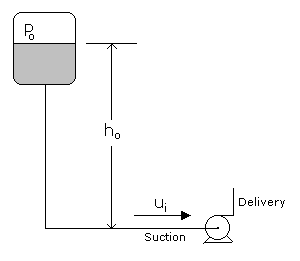
For any pump, the manufacturers specify the minimum value of the net positive suction head (NPSH) which must exist at the suction point of the pump. The NPSH is the amount by which the pressure at the suction point of the pump, expressed as the head of the liquid to be pumped, must exceed the vapor pressure of the liquid. For any installation this must be calculated, taking into account the absolute pressure of the liquid, the level of the pump, and the velocity and friction heads in the suction line. The NPSH must allow for the fall in pressure occasioned by the further acceleration of the liquid as it flows on to the impeller and for irregularities in the flow pattern in the pump. If the required value of NPSH is not obtained, partial vaporization if liable to occur, with the result that both the suction head and delivery head may be reduced. The loss of suction head is more important because it may cause the pump to be starved of liquid.
If the vapor pressure of liquid is Pv, the NPSH is the difference between the total head at the suction inlet and the head corresponding to the vapor pressure of the liquid at the pump inlet.


where Pv is the vapor pressure of the liquid being pumped.
If cavitation and loss of suction head does occur, it can sometimes be cured by increasing the pressure in the system, either by alteration of the layout to provide a greater hydrostatic pressure or a reduced pressure drop in the suction line. Sometimes, slightly closing the valve on the pump delivery or reducing the pump speed by a small amount may be effective. Generally a small fast-running pump will require a larger NPSH than a larger slow-running pump.
Last Modified on: 14-Sep-2014
Chemical Engineering Learning Resources - msubbu
e-mail: msubbu.in[AT]gmail.com
Web: http://www.msubbu.in